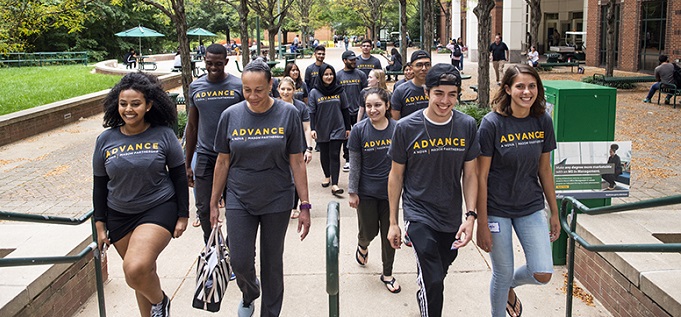Smoothing the transition
By Ed Finkel
February 3, 2021
The ADVANCE program helps students transition from a two-year college to a four-year university.
As with many community colleges and regional public universities, the path from Northern Virginia Community College (NOVA) to George Mason University in Fairfax, Virginia, has become heavily traveled over the years.
To smooth that path for students, the two schools in 2018 implemented the ADVANCE program, which among other benefits, assigns them one of six “success coaches,” who counsel them throughout their time at both schools and ensure they take the right courses, in the right order and in the most efficient way possible toward completion. The program also provides NOVA students with George Mason health insurance benefits and ID cards so they can use libraries and recreational facilities.
With 1,806 students enrolled as of fall 2020, the program celebrated its first four graduates in December. Of that total enrollment, 48% were first-generation college students, 60% were people of color and 61% were Pell grant eligible. They are able to transfer to Mason with no application fee, provided they have maintained at least a 2.5 grade point average (GPA) at NOVA. The spring 2019 cohort has had an 89% retention rate.
The impetus for the program was that, despite thousands of students transferring every year, NOVA students needed greater clarity to ensure no loss of credit, says Sheri Robertson, interim chief academic officer at NOVA.
“We’re gargantuan colleges,” she says. “Having one person who they can talk to is advantageous, and sort of comforting. The coaches … are helping the students figure out, ‘Alright, it sounds like you’re really not in the right program.’ Or ‘Gee, I see you did really badly this semester, maybe you need to take fewer classes,’ but in a positive light.”
Coaches are the linchpin, staying on top of shifts in program articulations over time, Robertson says.
“It’s very difficult to figure out not just how does this course transfer, but what courses should students take and in what order,” she says. “And then, as programs change, you have to do it every single year. And we have about 100 different pathways. This is a huge investment of time.”
Regular advisers at NOVA are familiar with the basics of how the program works and help students decide whether they need the extra assistance in the first place, she adds.
Ashlie Prioleau, executive director of ADVANCE, who along with the coaches is jointly employed by the two institutions, says conversations between the schools’ respective presidents led to a joint task force that did research underscoring the opportunities to improve the transfer process — most pointedly, that 80% of community college students said they wanted to achieve a bachelor’s degree, but only 15% were able to do so.
“These two presidents recognized the opportunity to turn around that alarming achievement gap,” she says.
Leadership required
Putting together a program like ADVANCE requires leadership buy-in, Robertson says.
“If you going to do this, you need a commitment from the president of both institutions,” Robertson says. “You need money, so you need your CFO involved. And you need time and patience. We have a draft MOU — which may sound funny because we’ve been doing this for four years now — spelling out in writing what everybody already knows.”
The program requires administrators and faculty from the two schools to routinely compare notes on policies and coursework, Robertson says.
“There’s more to it than figuring out, ‘What should I take if I want to be an English major?’ ” she says. “With policies, we asked ourselves are there ways we could modify ours so the students aren’t feeling like, ‘I did it this way at NOVA, but I’m doing it this way at Mason.’ ”
Prioleau put together the framework and groundwork starting with faculty conversations that ensured academic pathways matched course by course, down to the concentration, “so students do not get lost on their academic journey,” she says. “This is an access-driven program. It’s supposed to open the doors for students to achieve their dream.”
The coaches
The coaches themselves tend to be younger, but the institutions want to make sure they understand the background of typical community college students, Robertson says.
“Let’s say you want to go to the University of Virginia,” she says. “You might not be used to being around people from 129 different countries. A lot of times when people say ‘diverse,’ they’re talking about Black and White, or White and Asian.”
In addition, Robertson notes, some NOVA students have grown up expecting to go to college, while others have had to fight with their parents to matriculate.
“Having coaches who understand that population is super important,” she says. “Around here, people sometimes think a community college isn’t a ‘real’ college. … We have to make sure people don’t look down on us, especially if they’re going to work for us.”
There’s more to the story! Read the full article in CC Daily.



